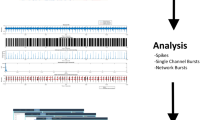Abstract
Emerging data have established links between paroxysmal neurological disorders or psychiatric disorder, such as migraine, ataxia, movement disorders and epilepsy. Common gene signatures such as expression, protein interaction and the associated signalling pathways link genes in these associated disorders, with the object to predict unknown disease or risk genes. In this study, we used gene interaction networks to investigate common gene signatures associated with the above phenotypes. In total, 19 candidate genes were used for making an interaction network which further revealed 39 associated genes (including KCNA1, SCN2A, CACNA1A, KCNM4, KCNO3, SCN1B and CACNB4) implicated in paroxysmal neurological disorders development and progression. The meta-regression analysis showed the strongest association of SCN2A with genes involved in schizophrenia and neurodevelopmental disorders. Importantly, our analysis showed KCNMA1 as a common gene signature with a link to epilepsy, movement disorders and wide paroxysmal neurological presentations—with the greatest potential risk of being a disease gene in a paroxysmal or psychiatric disorder. Further gene interaction analysis is required to identify unidentified gene interactions which may be targets for future drugs development.





Similar content being viewed by others
References
Lossin C, Wang DW, Rhodes TH, Vanoye CG, George AL Jr (2002) Molecular basis of an inherited epilepsy. Neuron 34(6):877–884
England MJ, Liverman CT, Schultz AM, Strawbridge LM (2012) Epilepsy across the spectrum: promoting health and understanding.: a summary of the Institute of Medicine report. Epilepsy Behav 25(2):266–276
World Health Organization. WHO press; (2006). Neurological disorders: public health challenges. Available: http://www.who.int/mental_health/neurology/neurodiso/en/index.html
Reynolds EH (2001) ILAE/IBE/WHO global campaign “out of the shadows”: global and regional developments. Epilepsia 42(8):1094–1100
Lhatoo SD, Sander JW (2005) Cause-specific mortality in epilepsy. Epilepsia 46:36–39
Engel J (2011) Biomarkers in epilepsy: introduction. Biomark Med 5(5):537–544
Hirtz D, Thurman DJ, Gwinn-Hardy K, Mohamed M, Chaudhuri AR, Zalutsky R (2007) How common are the “common” neurologic disorders? Neurology 68(5):326–337
Meyer AC, Dua T, Ma J, Saxena S, Birbeck G (2010) Global disparities in the epilepsy treatment gap: a systematic review. Bull World Health Organ 88:260–266
Theodore WH, Spencer SS, Wiebe S, Langfitt JT, Ali A, Shafer PO et al (2006) Epilepsy in North America: a report prepared under the auspices of the global campaign against epilepsy, the International Bureau for Epilepsy, the International League Against Epilepsy, and the World Health Organization. Epilepsia 47(10):1700–1722
Joutel A, Bousser MG, Biousse V, Labauge P, Chabriat H, Nibbio A et al (1993) A gene for familial hemiplegic migraine maps to chromosome 19. Nat Genet 5(1):40–45
Lipton RB, Ottman R, Ehrenberg BL, Hauser WA (1994) Comorbidity of migraine: the connection between migraine and epilepsy. Neurology 44(10 Suppl 7):S28–S32
Aurora SK, Cao Y, Bowyer SM, Welch KMA (1999) The occipital cortex is hyperexcitable in migraine: experimental evidence. Headache 39(7):469–476
Gardiner AR, Bhatia KP, Stamelou M, Dale RC, Kurian MA, Schneider SA et al (2012) PRRT2 gene mutations: from paroxysmal dyskinesia to episodic ataxia and hemiplegic migraine. Neurology 79(21):2115–2121
Gardiner A, Bhatia K, Stamelou M, Dale R, Kurian M, Schneider S et al (2013) PRRT2 gene mutations: from paroxysmal dyskinesia to episodic ataxia and hemiplegic migraine. Headache 53(4):693–694
N'Gouemo P (2011) Targeting BK (big potassium) channels in epilepsy. Expert Opin Ther Targets 15(11):1283–1295
Haut SR, Bigal ME, Lipton RB (2006) Chronic disorders with episodic manifestations: focus on epilepsy and migraine. The Lancet Neurology 5(2):148–157
De Boer HM, Mula M, Sander JW (2008) The global burden and stigma of epilepsy. Epilepsy Behav 12(4):540–546
Du W, Bautista JF, Yang H, Diez-Sampedro A, You SA, Wang L et al (2005) Calcium-sensitive potassium channelopathy in human epilepsy and paroxysmal movement disorder. Nat Genet 37(7):733–738
Piñero J, Queralt-Rosinach N, Bravo A, Deu-Pons J, Bauer-Mehren A, Baron M et al (2015) DisGeNET: a discovery platform for the dynamical exploration of human diseases and their genes. Database 2015
Ni P, Wang J, Zhong P, Li Y, Wu F, & Pan Y (2018). Constructing disease similarity networks based on disease module theory. IEEE/ACM transactions on computational biology and bioinformatics.http://bioinfogp.cnb.csic.es/tools/venny/
Wang J, Vasaikar S, Shi Z, Greer M, Zhang B (2017) WebGestalt 2017: a more comprehensive, powerful, flexible and interactive gene set enrichment analysis toolkit. Nucleic Acids Res 45(W1):W130–W137
Warde-Farley D, Donaldson SL, Comes O, Zuberi K, Badrawi R, Chao P, ... & Maitland A (2010). The GeneMANIA prediction server: biological network integration for gene prioritization and predicting gene function. Nucleic Acids Research, 38(suppl_2), W214-W220. https://genecards.weizmann.ac.il/v3/cgi-bin/carddisp.pl?gene=KCNMA1
Erro R, Bhatia KP, Espay AJ, Striano P (2017) The epileptic and nonepileptic spectrum of paroxysmal dyskinesias: channelopathies, synaptopathies, and transportopathies. Mov Disord 32(3):310–318
International League Against Epilepsy Consortium on Complex Epilepsies. Electronic address e-auea (2014) Genetic determinants of common epilepsies: a meta-analysis of genome-wide association studies. The Lancet Neurology 13(9):893–903
Schwarz N, Bast T, Gaily E, Golla G, Gorman KM, Griffiths LR, ... & Miranda MJ (2019). Clinical and genetic spectrum of SCN2A-associated episodic ataxia. Eur J Paediatr Neurol, 23(3), 438–447
Wolff M, Johannesen KM, Hedrich UB, Masnada S, Rubboli G, Gardella E et al (2017) Genetic and phenotypic heterogeneity suggest therapeutic implications in SCN2A-related disorders. Brain 140(5):1316–1336
Dilena R, Striano P, Gennaro E, Bassi L, Olivotto S, Tadini L, Mosca F, Barbieri S, Zara F, Fumagalli M (2017) Efficacy of sodium channel blockers in SCN2A early infantile epileptic encephalopathy. Brain Dev 39(4):345–348
Author information
Authors and Affiliations
Corresponding author
Ethics declarations
Conflict of interest
The authors declare that they have no conflict of interest.
Ethical standards
The whole analysis is computational based and therefore no human participant was involved in this study.
Additional information
This work was performed during the fellowship sponsored by the Charles Wallace Research Fellowship, British Council Pakistan.
Publisher’s note
Springer Nature remains neutral with regard to jurisdictional claims in published maps and institutional affiliations.
Rights and permissions
About this article
Cite this article
Ilyas, M., Salpietro, V., Efthymiou, S. et al. Identification of common genetic markers of paroxysmal neurological disorders using a network analysis approach. Neurol Sci 41, 851–857 (2020). https://doi.org/10.1007/s10072-019-04113-w
Received:
Accepted:
Published:
Issue Date:
DOI: https://doi.org/10.1007/s10072-019-04113-w




